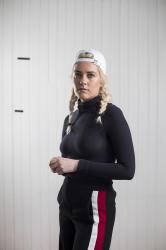
As a flicker of light appears at the end of the pandemic tunnel, we sat down with the next generation of Icelandic artists to discuss the future. The conversations were freeform—some focused on the upcoming years, others reflected on realisations from the past months, others still looked with wide-eyes at the future of the scene, which has only grown within the restrictions of the coronavirus.
Presenting, an artistic vision of the future, as told by the future. Today, we talk to Arngrímur Sigurðsson.

Arngrímur Sigurðsson. Photo by Art Bicnick
Arngrímur Sigurðsson
“Just before COVID, I was reading a lot by William Blake and I was getting interested in the idea of a sort of final struggle between the industrial world and the environment. I had a go at writing a few poems with these apocalyptic themes, a kind of war between the environment and industry, and all these monsters were coming out. So it was something in the air,” Arngrímur Sigurðsson explains. “I’ve always been working with the idea that people are subject to natural forces rather than the other way around.”
Arngrímur’s work runs the gamut of styles, but he’s most well-known for his visceral depictions of fantastical creatures and beings—monsters, mainly. And perhaps it’s because Arngrímur spends so much time dealing with such dark subject matter, but he’s remarkably pragmatic when he talks about the pandemic. Unlike most others, he doesn’t take its effects personally but regards it merely as a part of the life cycle.
“It’s a natural catastrophe,” he states simply. “It’s like predators. Their role in nature is a symbiotic one. The ecosystem is dependent on all these different sorts of factors to keep it in balance. And when you mess with that…” he trails off.

Artwork by Arngrímur Sigurðsson.
History repeats itself
Arngrímur is more interested in humanity’s response to chaos and points to the current worldwide reaction to the pandemic as the ultimate evidence of the phrase “History repeats itself.”
“With any sort of monsters, especially in folklore traditions from more extreme climates, they usually manifest as symbolic representations of natural phenomena depicted in a way that fits a certain worldview or moral narrative. People often try to make some character out of it—to anthropomorphise natural forces,” he explains. “This same tendency to cherry pick unrelated events and causally connecting them to fit a certain worldview is something you can also see in COVID.”
He points to the rise in conspiracy theories as evidence.
“The internet and social media is full of magical thinking and groups [like] QAnon present an ideology that, like folklore, is both supernatural and superstitious. Their reality has borrowed the classic mythological theme of the battle between good and evil, with Trump as the hero archetype uprooting the evil forces that lurk in the undergrowth,” he continues.

Artwork by Arngrímur Sigurðsson.
The storyteller of our age
“Artificial Intelligence is emerging as the storyteller of our age. Algorithms profile your behaviour online and target you with material you are likely to click. So if your behaviour suggests you are susceptible to conspiracy or superstition, the platforms will encourage you further and further down your personal rabbit hole,” he says, adopting a more serious tone. “And this has a lot to do with imagination. We can imagine that the world is this way or that way, depending on our particularities. And maybe these are world views that might not have much to do with reality, but it works for a lot of people.”
“So when we think about monsters, or something supernatural or superstitious, we think it’s silly, it’s not scientific. We know better,” he concludes. “But then when the shit hits the fan, there is a catastrophe or a pandemic, the same human tendencies and inclinations as before creep out and manifest in our experience.”
And a new monster is born.

Artwork by Arngrímur Sigurðsson.
Check out Arngrímur Sigurðsson at his website and pick up his artworks at Myrkraverk Studio at Skólavörðustígur. You can also pick up his book ‘Museum of Hidden Beings’ at the Grapevine shop here.
Note: Due to the effect the Coronavirus is having on tourism in Iceland, it’s become increasingly difficult for the Grapevine to survive. If you enjoy our content and want to help the Grapevine’s journalists do things like eat and pay rent, please consider joining our High Five Club.
You can also check out our shop, loaded with books, apparel and other cool merch, that you can buy and have delivered right to your door.
Buy subscriptions, t-shirts and more from our shop right here!















